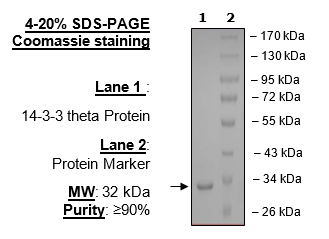14-3-3 theta Protein, His-tag (Human) Recombinant
Catalog #
79038
$395
*
●
●
Purchase
Description
Human 14-3-3 theta Protein, GenBank Accession No. NM_006826, full length, with N-terminal His-tag, expressed in Sf9 insect cells using baculovirus. MW = 30 kDa.
●
Synonyms
YWHAQ, 1C5, HS1, 14-3-3
●
Product Data Gallery
Product Info
Storage and Usage
Citations
Species
Human
Host Species/Expression System
Sf9 insect cells using baculovirus
Formulation
50mM sodium phosphate, pH 7.0, 300mM NaCl, 150mM imidazole, 0.1mM PMSF, 0.25mM DTT, 25% glycerol.
MW
32 kDa
Amino Acids
Full length
Genbank #
NM_006826
UniProt #
P27348
Background
14-3-3 theta (also known as tyrosine 3-monooxygenase /tryptophan 5-monooxygenase activation protein, theta polypeptide) is a member of the 14-3-3 family of proteins which mediate signal transduction by binding to phosphoserine-containing proteins. Through interaction with ASK1, c-jun NH-terminal kinase, and p38 mitogen-activated protein kinase (MAPK), 14-3-3 theta plays an important role in controlling apotopsis (1). Induced expression of 14-3-3 theta protein has been reported in patients with amyotrophic lateral sclerosis. Additionally, 14-3-3 theta has been observed to mediate nucleo-cytoplasmic shuttling of the N protein (coronavirus nucleocapsid protein) which causes severe acute respiratory syndrome (2).
References
1. Lau, J.M. et al: The 14-3-3tau phosphoserine-binding protein is required for cardiomyocyte survival. Mol Cell Biol. 2007, 27(4):1455-66.
2. The severe acute respiratory syndrome coronavirus nucleocapsid protein is phosphorylated and localizes in the cytoplasm by 14-3-3-mediated translocation.J Virol. 2005 Sep;79(17):11476-86.


